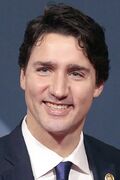| President of Canada
Président du Canada Presidente de Canadá | |
|---|---|
| Style | The Right Honourable |
| Residence | 24 Sussex Drive Ottawa, CC |
| Appointer | Parliament |
| Term length | At the pleasure of Parliament, elections every four years unless dissolved sooner |
| Formation | 1920 |
The President of Canada (French: Président du Canada, Spanish: Presidente de Canadá) is both the head of state and head of government in Canada, charged with the use of executive powers granted to him as stated in the Canadian constitution. The office is currently held by Justin Trudeau.
Preceding offices (1867-1920)[]
The office was created in 1920, combining the positions of Prime Minister, Governor-General, and Monarch.
Prime Minister[]
The position of "Prime Minister" had not been mentioned in any pre-1920 constitutional document. The office and its functions were instead governed by British constitutional conventions and traditions. This meant that, in practice, he held the majority of executive power. The first person to hold the title of Prime Minister was Sir John A. Macdonald, the last being Sir Robert Borden.
Governor-General[]
In theory, the Governor-General's role, as outlined in the British North America Act or 1867, was permitted to exercise nearly all executive, legislative, and judicial power in and over Canada in the name of the Monarch, although the Monarch still legally retained such power. It was his duty to appoint members-for-life to the King's/Queen's Privy Council. It was usually held by nobility from the UK. The first person to hold the title of Governor-General was Charles Monck, the 4th Viscount Monck, the last being Victor Cavendish, 9th Duke of Devonshire.
Monarch[]
Though they were separate titles and positions, the Monarch of the United Kingdom and Monarch of Canada were always the same person. In theory, the monarch held all executive, legislative, and judicial power over Canada, although he/she permitted the Governor-General to exercise it in his/her name. The first monarch was Queen Victoria, the last being George V.
Presidents of the First Republic (1920-1941)[]
The office of President was created in 1920. With the exception of combining the three aforementioned titles, the 1920 constitution codified into law what had been common practice in Canada and the UK for a long time, with very minor, mostly ceremonial, changes. Every four years, parliamentary elections to the House of Commons would be held with universal male suffrage, though elections could be called early. The leader of the party with the most seats would become President, being sworn in by his predecessor. The first President of Canada was [NAME]. The last President under this constitution was [NAME].
Presidents of the Second Republic (1941-present)[]
The 1941 constitution made many changes in different areas. Following R. B. Bennett's handling of the Quebec Crisis, it was clear that major checks on the President's power were necessary. According to the 1941 constitution, the Opposition Leader may veto any and all executive actions of the President, including the signing of bills into law. These vetoes must then be put to a vote in Parliament, requiring the vote of forty percent of the House of Commons. The Chief Justice of Canada also has the right to order a constitutional review of any of the President's executive actions. The first President under the current constitution was [NAME], with the position being currently held by Justin Trudeau.

